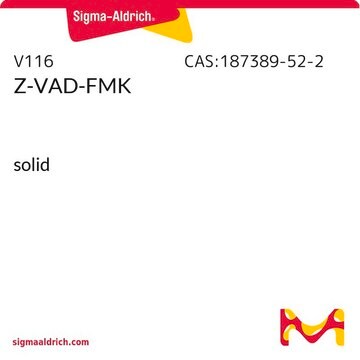N9037
Necrostatin-1
≥98% (HPLC), powder, necroptosis inhibitor
Sinónimos:
5-(1H-Indol-3-ylmethyl)-3-methyl-2-thioxo-4-Imidazolidinone, 5-(Indol-3-ylmethyl)-3-methyl-2-thio-Hydantoin, MTH-DL-Tryptophan
Seleccione un Tamaño
Seleccione un Tamaño
About This Item
Productos recomendados
Nombre del producto
Necrostatin-1, ≥98% (HPLC)
Nivel de calidad
Ensayo
≥98% (HPLC)
Formulario
powder
solubilidad
DMSO: >10 mg/mL
temp. de almacenamiento
−20°C
cadena SMILES
CN1C(=S)NC(Cc2c[nH]c3ccccc23)C1=O
InChI
1S/C13H13N3OS/c1-16-12(17)11(15-13(16)18)6-8-7-14-10-5-3-2-4-9(8)10/h2-5,7,11,14H,6H2,1H3,(H,15,18)
Clave InChI
TXUWMXQFNYDOEZ-UHFFFAOYSA-N
Aplicación
Acciones bioquímicas o fisiológicas
Características y beneficios
Código de clase de almacenamiento
11 - Combustible Solids
Clase de riesgo para el agua (WGK)
WGK 3
Punto de inflamabilidad (°F)
Not applicable
Punto de inflamabilidad (°C)
Not applicable
Equipo de protección personal
Eyeshields, Gloves, type N95 (US)
Elija entre una de las versiones más recientes:
Certificados de análisis (COA)
¿No ve la versión correcta?
Si necesita una versión concreta, puede buscar un certificado específico por el número de lote.
¿Ya tiene este producto?
Encuentre la documentación para los productos que ha comprado recientemente en la Biblioteca de documentos.
Artículos
Apoptosis regulation involves multiple pathways and molecules for cellular homeostasis.
Cell cycle phases (G1, S, G2, M) regulate cell growth, DNA replication, and division in proliferating cells.
Active Filters
Nuestro equipo de científicos tiene experiencia en todas las áreas de investigación: Ciencias de la vida, Ciencia de los materiales, Síntesis química, Cromatografía, Analítica y muchas otras.
Póngase en contacto con el Servicio técnico







